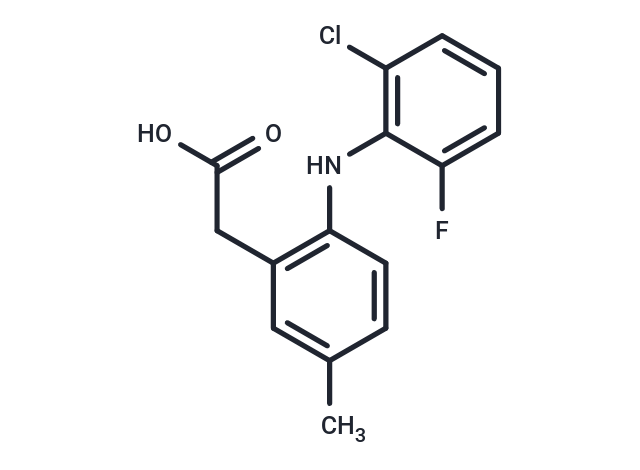Shopping Cart
- Remove All
 Your shopping cart is currently empty
Your shopping cart is currently empty

Lumiracoxib (Prexige) is a novel, selective COX-2 inhibitor with IC50 and Ki of 0.14 μM and 0.06 μM, exhibits 515-fold selectivity over COX-1. Phase 4.

| Pack Size | Price | Availability | Quantity |
|---|---|---|---|
| 10 mg | $31 | In Stock | |
| 25 mg | $48 | In Stock | |
| 50 mg | $70 | In Stock |
| Description | Lumiracoxib (Prexige) is a novel, selective COX-2 inhibitor with IC50 and Ki of 0.14 μM and 0.06 μM, exhibits 515-fold selectivity over COX-1. Phase 4. |
| Targets&IC50 | COX-2 (cell-free assay):Ki:60 nM, COX-1 (cell-free assay):Ki:3 μM |
| In vitro | Lumiracoxib has an IC50 of 0.14 μm in COX-2-expressing dermal fibroblasts, but caused no inhibition of COX-1 at concentrations up to 30 μm (HEK 293 cells transfected with human COX-1). In a human whole blood assay, IC50 values for Lumiracoxib are 0.13 μM for COX-2 and 67 μM for COX-1 (COX-1/COX-2 selectivity ratio 515). |
| In vivo | Lumiracoxib is a highly selective COX-2 inhibitor with anti-inflammatory, analgesic and antipyretic activities comparable with diclofenac, the reference NSAID, but with much improved gastrointestinal safety. Lumiracoxib is rapidly absorbed following oral administration in rats with peak plasma levels being reached between 0.5 and 1 h. Efficacy of Lumiracoxib in rat models of hyperalgesia, oedema, pyresis and arthritis is dose-dependent and similar to diclofenac. However, consistent with its low COX-1 inhibitory activity, Lumiracoxib at a dose of 100 mg/kg orally causes no ulcers and is significantly less ulcerogenic than diclofenac. |
| Animal Research | Animal Models: Female Lewis ratsFormulation: Sterile phosphate-buffered salineDosages: 0.2–2 mg/kgAdministration: Oral gavage |
| Alias | Prexige, COX-189 |
| Molecular Weight | 293.72 |
| Formula | C15H13ClFNO2 |
| Cas No. | 220991-20-8 |
| Smiles | N(C1=C(CC(O)=O)C=C(C)C=C1)C2=C(Cl)C=CC=C2F |
| Relative Density. | 1.363 g/cm3 (Predicted) |
| Storage | store at low temperature | Powder: -20°C for 3 years | In solvent: -80°C for 1 year | Shipping with blue ice. | |||||||||||||||||||||||||||||||||||
| Solubility Information | H2O: < 1 mg/mL (insoluble or slightly soluble) Ethanol: < 1 mg/mL (insoluble or slightly soluble) DMSO: 55 mg/mL (187.25 mM), Sonication is recommended. | |||||||||||||||||||||||||||||||||||
Solution Preparation Table | ||||||||||||||||||||||||||||||||||||
DMSO
| ||||||||||||||||||||||||||||||||||||

Copyright © 2015-2025 TargetMol Chemicals Inc. All Rights Reserved.